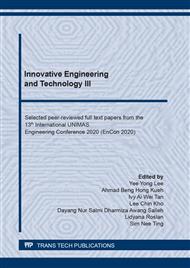[1]
Q. Chai, Y. Jiao, and X. Yu, Hydrogels for biomedical applications: Their characteristics and the mechanisms behind them, Gels 3 (2017) 6.
DOI: 10.3390/gels3010006
Google Scholar
[2]
Y. Teow, K. Ming, and A. Mohammad, Synthesis of cellulose hydrogel for copper (II) ions adsorption, J. Environ. Chem. Eng. 6 (2018) 4588–4597.
DOI: 10.1016/j.jece.2018.07.010
Google Scholar
[3]
L. J. del Valle, A. Díaz, and J. Puiggalí, Hydrogels for Biomedical Applications: Cellulose, Chitosan, and Protein/Peptide Derivatives, Gels 3 (2017) 1–28.
DOI: 10.3390/gels3030027
Google Scholar
[4]
M. Onofrei and A. Filimon, Cellulose-based hydrogels : Designing concepts, properties, and perspectives for biomedical and environmental applications, Polym. Sci. (2012) 108–120.
Google Scholar
[5]
J. J. Escobar-Chávez, M. López-Cervantes, A. Naïk, Y. N. Kalia, D. Quintanar-Guerrero, and A. Ganem-Quintanar, Applications of thermo-reversible pluronic F-127 gels in pharmaceutical formulations, J. Pharm. Pharm. Sci. 9 (2006) 339–358.
DOI: 10.18433/j3201z
Google Scholar
[6]
M. Marques et al., Topical and transdermal drug products, Pharmacopeial Forum 35 (2009) 750–764.
Google Scholar
[7]
V. P. Shah, J. Elkins, S. Shaw, and R. Hanson, In vitro release: Comparative evaluation of vertical diffusion cell system and automated procedure, Pharm. Dev. Technol. 8 (2003) 97–102.
DOI: 10.1081/pdt-120017528
Google Scholar
[8]
R. R. Klein, J. L. Heckart, and K. D. Thakker, In Vitro Release Testing Methodology and Variability with the Vertical Diffusion Cell (VDC), Dissolution Technol. (2018) 52–61.
DOI: 10.14227/dt250318p52
Google Scholar
[9]
S. Klein, Influence of different test parameters on in vitro drug release from topical diclofenac formulations in a vertical diffusion cell setup, Pharmazie 68 (2013) 565–571.
Google Scholar
[10]
E. Ghedini et al., Sulfadiazine-based drug delivery systems prepared by an effective sol–gel process, J. Sol-Gel Sci. Technol. 83 (2017) 618–626.
DOI: 10.1007/s10971-017-4446-4
Google Scholar
[11]
N. M. Morsi, G. A. Abdelbary, and M. A. Ahmed, Silver sulfadiazine based cubosome hydrogels for topical treatment of burns: Development and in vitro/in vivo characterization, Eur. J. Pharm. Biopharm. 86 (2014) 178–189.
DOI: 10.1016/j.ejpb.2013.04.018
Google Scholar
[12]
USP, Buffer Solutions, United States Pharmacopoeia 41 (2018) 5748–5749.
Google Scholar
[13]
F. M. Mustafa and H. A. Hodali, Use of mesoporous silicate nanoparticles as drug carrier for mefenamic acid, IOP Conf. Ser. Mater. Sci. Eng. 92 (2015).
DOI: 10.1088/1757-899x/92/1/012018
Google Scholar
[14]
S. Dharashivkar, S. Sahasrabuddhe, and A. Saoji, Silver sulfadiazine niosomes: A novel sustained release once a day formulation for burn treatment, Int. J. Pharm. Pharm. Sci. 6 (2014) 611–616.
Google Scholar
[15]
S. Ng, J. Rouse, D. Sanderson, and G. Eccleston, A Comparative Study of Transmembrane Diffusion and Permeation of Ibuprofen across Synthetic Membranes Using Franz Diffusion Cells, Pharmaceutics 2 (2010) 209–223.
DOI: 10.3390/pharmaceutics2020209
Google Scholar
[16]
H. A. Pawar and P. R. Joshi, Development and Validation of a Discriminating In Vitro Dissolution Method for Oral Formulations Containing Satranidazole , Int. J. Spectrosc. 2014 (2014) 1–7.
DOI: 10.1155/2014/624635
Google Scholar
[17]
A. Luís, M. Ruela, A. G. Perissinato, M. Esselin, and D. S. Lino, Evaluation of skin absorption of drugs from topical and transdermal formulations, Brazilian J. Pharm. Sci. 52 (2016) 527–544.
DOI: 10.1590/s1984-82502016000300018
Google Scholar
[18]
Q. Bao and D. J. Burgess, Perspectives on Physicochemical and In Vitro Profiling of Ophthalmic Ointments, Pharm. Res. 35 (2020) 234.
DOI: 10.1007/s11095-018-2513-3
Google Scholar
[19]
P. Liu et al., Dissolution studies of poorly soluble drug nanosuspensions in non-sink conditions, AAPS PharmSciTech 14 (2013) 748–756.
DOI: 10.1208/s12249-013-9960-2
Google Scholar
[20]
R. Neupane, S. H. S. Boddu, J. Renukuntla, R. J. Babu, and A. K. Tiwari, Alternatives to biological skin in permeation studies: Current trends and possibilities, Pharmaceutics 12 (2020).
DOI: 10.3390/pharmaceutics12020152
Google Scholar


